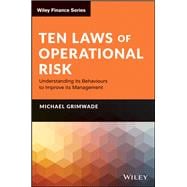Unlike credit and market risk, operational risk currently lacks an overarching theory to explain how and why losses occur. As a result, operational risk managers have been forced to use unsatisfactory tools and processes that fail to add sufficient commercial value.
In Ten Laws of Operational Risk: Understanding its Behaviours to Improve its Management, Michael Grimwade delivers an insightful discussion of the nature of operational risk and a groundbreaking redesign of the profession???s existing tools. The author???s Ten Laws are grounded on the business profiles of firms and the human and institutional behaviours that drive operational risk. They are underpinned by taxonomies for the causes; the inadequacies or failures that constitute both control failures and events; and the impacts of operational risks.
Drawing on twenty-five years of first-hand experience and research, this book explains the patterns and trends that are apparent in the historical data and offers solutions to the persistent problems inherent in risk appetite, RCSAs, scenario analysis, reputational risk, stress testing, capital modeling, and insurance. It also provides fresh insights into the everyday activities of risk managers with respect to predictive key risk and control indicators, root cause analysis, why controls fail, the risks posed by change, and product risk profiles.
Ten Laws of Operational Risk presents a structured and evidence-based approach to identifying emerging risks and predicting future behaviours related to pandemics, climate change, cybercrime, artificial intelligence, and machine learning. It includes revealing industry data, in-depth case studies, and real-world examples that shed light on recurring and obstinate problems in operational risk management.
A must-read resource for Chief Risk Officers and other risk professionals, as well as regulators, management consultants, and students and scholars of operational risk, Ten Laws of Operational Risk provides an invaluable new, systematic, and rigorous approach to operational risk management.
PRAISE FOR TEN LAWS OF OPERATIONAL RISK
???Operational Risk can no longer be described as a new concept, but as a discipline few attempts have been made to really understand its behaviour. In his book Michael does this very successfully, blending extensive practical experience with analytical thought leadership to propose a set of laws that explain why and how Operational Risks arise, and what can be done to manage them. Assertions are evidence based, with numerous real examples used to underpin his hypotheses. This is a valuable addition to Operational Risk thinking and is recommended for experienced professionals and novices alike.???
??? Dr Luke Carrivick, Director of Research & Information, ORX
???Michael has established himself as one of Operational Risk???s foremost thinkers. His ability to use historical data to analyse events is unrivalled. In this must-read book, he identifies ten fundamental laws that provide every Operational Risk practitioner with a clear set of rules they can use to understand current events and predict their impacts.???
??? Andrew Sheen, former Head of the FSA???s Operational Risk Review team
???Michael is one of the most prominent thinkers in Operational Risk. He combines a long career in Operational Risk management and measurement with a deep, long-standing reflection on the fundamental causes, dynamics and patterns in the manifestation of Operational Risk events. He produces, with this book, a remarkable synthesis of his insightful and innovative work.???
??? Dr Ariane Chapelle, Honorary Reader, University College London; Managing Partner, Chapelle Consulting
???Michael is a highly respected expert in the field of Operational Risk, who has developed some ground-breaking frameworks for analysing this risk and guiding better risk management decisions. As a working practitioner in the field he brings many insights that will appeal to other practitioners as well as regulators, students and scholars.???
??? Professor Elizabeth Sheedy, Macquarie Business School
???Michael???s views and analysis challenge the traditional Basel II views of Operational Risk and are genuinely thought-provoking. His book on the Ten Laws of Operational Risk will give financial services clarity and a practical view, where it has been previously lacking, on how best to manage such risks.???
??? Tin Lau, Group Head of Financial and Strategic Risk, TP ICAP









